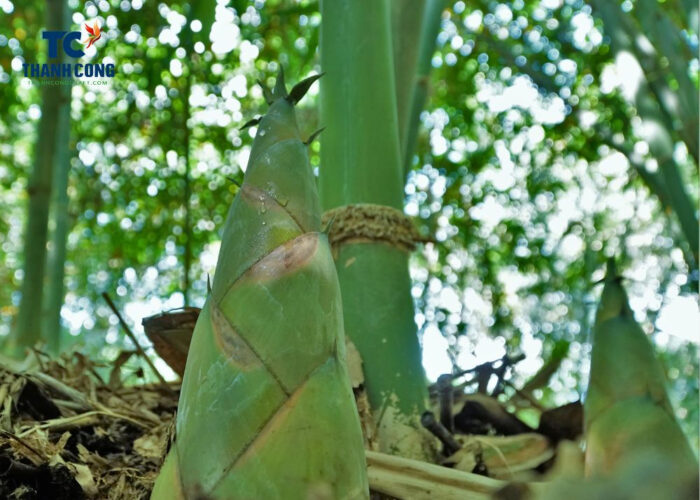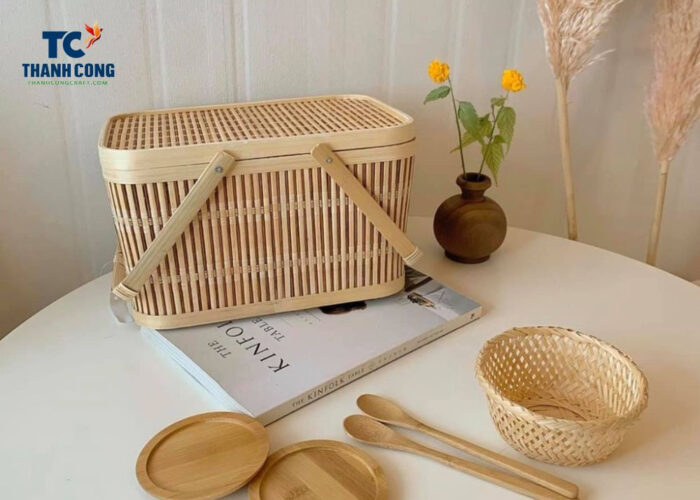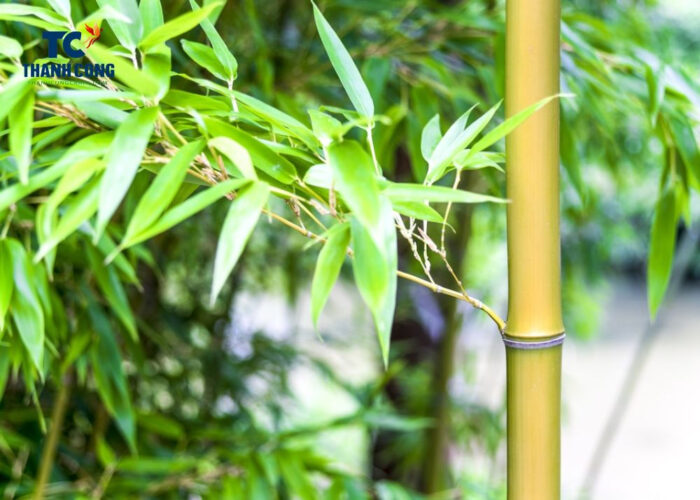-
31-08-2023, 04:26 PM #1
 Silver member
Silver member
- Ngày tham gia
- Jul 2023
- Bài viết
- 151
What Does Bamboo Look Like When It First Starts Growing
Delving into the fascinating world of bamboo, we unravel the captivating transformation that this remarkable plant undergoes during its initial stages of growth. What Does Bamboo Look Like When It First Starts Growing? From its delicate shoots breaking through the soil to the gradual development of its iconic segmented stalks, let’s embark on a journey to discover the intriguing appearance and growth process of bamboo in its nascent phase.
1. What does bamboo look like when it first starts growing
What does young bamboo look like, bamboo is a type of grass that can grow very fast and tall. When it first starts growing, bamboo looks like a small green shoot that emerges from the soil. The bamboo shoots are pointed and sharp, enveloped by layers of deep purple-brown sheaths that are adorned with vibrant hairs. The shoot grows vertically until it reaches its maximum height, which can vary from a few centimeters to over 30 meters. Then, it starts to produce leaves and branches from the nodes. The shoot becomes a mature cane after one or two years, and can live for several years before dying.

Bamboo is a type of grass that can grow very fast and tall
2. What does bamboo look like growing
Bamboo as it grows exhibits a distinct appearance. Initially, delicate shoots emerge from the soil, enveloped in protective sheaths. As growth progresses, these sheaths unfurl to reveal young leaves that eventually expand into lush foliage. The shoots may sport a lighter shade of green and their height varies by species. With time, these shoots transform into the iconic segmented stems that characterize bamboo.
3. What type of bamboo grows the fastest
Phyllostachys edulis, commonly known as Moso bamboo, is renowned for being one of the fastest-growing bamboo species. This giant timber bamboo can achieve impressive growth rates, sometimes growing up to 2 feet (60 centimeters) or more in a single day under optimal conditions. Its rapid growth makes it a popular choice for commercial purposes, construction, and various applications where quick establishment of bamboo is desired.
4. Some applications of bamboo in daily life
In addition to the Uses of bamboo plants at home, bamboo also has several other applications as follows:
- Crafting Essential Household Items: Bamboo renowned for its versatility and eco-friendliness, plays a pivotal role in creating indispensable household items. Its unique attributes make it a top choice for crafting functional and appealing products. From bowls, plates, wholesale bamboo basket and cutting boards to cups, utensils, and storage solutions, bamboo’s lightweight strength and natural charm make it a sustainable alternative.

Bamboo renowned for its versatility and eco-friendliness
- Furniture and Decor: Bamboo furniture brings a sense of natural beauty to living spaces. From chairs and tables to shelves and bed frames, bamboo’s lightweight yet sturdy nature makes it a favorite material for crafting contemporary and sustainable furniture. In the realm of decor, bamboo’s appeal knows no bounds such as: Lampshades, room dividers and wall hangings crafted from bamboo create a soothing ambiance and a connection to nature. Picture frames and mirrors adorned with bamboo accents offer a unique visual appeal.
- Textiles and Accessories: Bamboo fibers, transformed into textiles, create garments of exceptional comfort and functionality. From shirts and dresses to undergarments and activewear, bamboo textiles offer a soft touch against the skin, while also being hypoallergenic and eco-friendly. Bamboo accessories add an earthy and chic dimension to personal style. Bamboo-based jewelry, watches, and sunglasses showcase the material’s adaptability and aesthetic appeal. Bamboo hats and bags merge fashion with sustainability, offering a blend of utility and elegance.
- Kitchenware: Bamboo takes center stage in the world of kitchenware, seamlessly combining functionality, sustainability, and aesthetic appeal to elevate the culinary experience. Bamboo’s versatility shines through in the crafting of cooking utensils. Spatulas, Wholesale Bamboo Cups, spoons, and tongs made from bamboo offer a safe and gentle touch to cookware while being heat-resistant and non-scratch. These utensils are perfect companions for both amateur and professional chefs, ensuring a seamless cooking process.
Bamboo takes center stage in the world of kitchenware
- Gardening and Agriculture: Bamboo’s tall and sturdy culms make it an ideal choice for providing support to climbing plants. Gardeners utilize bamboo stakes to guide vines, ensuring healthy growth and efficient space utilization. Bamboo’s natural elegance also extends to landscaping, where it creates visually appealing barriers, screens, and borders. Bamboo fencing serves as both a functional and decorative element in agricultural settings. It offers privacy, protection, and demarcation, while also being an eco-friendly alternative to traditional fencing materials.
5. Some Questions Related To Bamboo
5.1. What are the different types of bamboo
There are different types of bamboo around the world. Here are some common types:
- Phyllostachys Bamboo: This type of bamboo has red or greenish-red stems and is known for its fast growth. Some popular varieties include Phyllostachys aureosulcata, Phyllostachys nigra (black bamboo), and Phyllostachys viridis (green bamboo).
- Bambusa Bamboo: This type of bamboo has thick and tall culms (stems). Some common varieties are Bambusa textilis (weaver’s bamboo), Bambusa vulgaris (common bamboo), and Bambusa oldhamii (giant timber bamboo).
This type of bamboo has red or greenish-red stems
- Fargesia Bamboo: This type of bamboo is suitable for smaller spaces. Some popular varieties include Fargesia murieliae (umbrella bamboo) and Fargesia spathacea (blue fountain bamboo).
- Dendrocalamus Bamboo: This type of bamboo has thick culms and strong branching. Dendrocalamus strictus (bamboo maida) and Dendrocalamus giganteus (giant bamboo) are commonly found in this group.
- Guadua Bamboo: This type of bamboo is known for its large size and high strength. It is widely used in construction and furniture making.
These are just a few common types of bamboo. There are many different species of bamboo worldwide and in different geographical regions.
5.2. What type of bamboo grows the fastest
The Phyllostachys bamboo species are generally known for their fast growth rates. Within the Phyllostachys genus, Phyllostachys edulis (commonly known as Moso bamboo) is particularly renowned for its rapid growth. Moso bamboo can grow up to 1 meter (3 feet) per day under optimal conditions. It is one of the fastest-growing plants on Earth. However, it’s important to note that the growth rate can vary depending on various factors such as climate, soil conditions, and cultivation practices.
5.3. What are the types of bamboo
Bamboo is an incredibly versatile plant boasting a diverse range of species and cultivars. Here are some prevalent types of bamboo:
- Timber Bamboo: This group encompasses sizable bamboo species known for their towering growth and robust culms. Dendrocalamus giganteus and Bambusa oldhamii exemplify this category.
- Clumping Bamboo: These bamboo varieties form compact, non-invasive clusters. They’re particularly suitable for limited garden space and container planting. Bambusa multiplex and Fargesia sp. Are notable examples.

Dendrocalamus giganteus and Bambusa oldhamii exemplify this category
- Running Bamboo: Running bamboo types spread rapidly through underground rhizomes and can become invasive if not effectively controlled. Phyllostachys species, including Phyllostachys aureosulcata and Phyllostachys nigra, fall under this category.
- Dwarf Bamboo: These diminutive bamboo species serve well as ground cover or for cultivation in pots. Pleioblastus species like Pleioblastus fortunei and Pleioblastus pygmaeus are representative examples of this classification.
5.4. Is bamboo considered wood
Bamboo belongs to the group of evergreen, woody plants with clumping root structures, and its inner stem is hollow. Although bamboo is not classified as wood, it is a type of grass that significantly differs from other grasses. In fact, bamboo grass can be tougher than oak wood, depending on the type, species, and geographic region in which it grows. The distinctive feature of bamboo grass lies in its thickness and substantial size compared to other grasses. Bamboo holds significant value in our daily lives. Furthermore, bamboo is recognized as a resource for the future and is often referred to as the ‘green steel’ in construction.”
5.5. What type of bamboo is used for building
Some specific bamboo species used for building purposes include Dendrocalamus asper, Phyllostachys edulis (Moso bamboo), Bambusa balcooa, and Guadua angustifolia. These species are known for their strength, straightness, and suitability for construction applications such as scaffolding, framing, flooring, and even entire structures like houses and bridges.View more random threads:
- Thuê xe hợp đồng và những điều bạn cần lưu ý
- Mẫu pallet nhựa màu đen bán chạy nhất thị trường năm 2023
- Làm thế nào để có thể hiểu rõ hơn về Yoga
- Các máy rung tốt, được ưa chuộng nhất từ người chơi
- Exploring the Charm and Versatility of Round Bamboo Baskets
- điều gì về Trường Cao đẳng Kỹ thuật - Mỹ nghệ Việt Nam mọi người thường hiểu sai
- Thẩm Mỹ Mắt Giá Bao Nhiêu Hiện Nay?
- Cùng đặt tên cho mạng kính thiên văn vô tuyến của Mỹ
- Grand Riverside phòng ốc thông thoáng giỏ hàng mới
- Nồi hơi công nghiệp vận hành mau cạn nước là do đâu
Các Chủ đề tương tự
-
How To Care For Bamboo Utensils?
Bởi Thanhcongcraft trong diễn đàn Mua bán tổng hợpTrả lời: 0Bài viết cuối: 25-08-2023, 11:44 AM -
Crafting Elegance: The Allure of Small Bamboo Baskets
Bởi Thanhcongcraft trong diễn đàn Mua bán tổng hợpTrả lời: 0Bài viết cuối: 05-08-2023, 10:28 AM -
Enchanting Illumination: The Magic of Hanging Bamboo Lanterns
Bởi Thanhcongcraft trong diễn đàn Mua bán tổng hợpTrả lời: 0Bài viết cuối: 02-08-2023, 02:26 PM -
Exploring the Charm and Versatility of Round Bamboo Baskets
Bởi Thanhcongcraft trong diễn đàn Mua bán tổng hợpTrả lời: 0Bài viết cuối: 31-07-2023, 03:03 PM -
Eco-Chic Illumination: Bamboo Ceiling Lamp Shade
Bởi Thanhcongcraft trong diễn đàn Mua bán tổng hợpTrả lời: 0Bài viết cuối: 14-07-2023, 01:41 PM



 Trả lời kèm Trích dẫn
Trả lời kèm Trích dẫn





Gel bôi trơn là một loại sản phẩm được dùng riêng cho hoạt động tình dục. Chất gel này có tác dụng bôi trơn, giảm ma sát của âm đạo với dương vật hoặc với các bộ phận khác trên thân. Nhờ có chất bôi...
Nước bôi trơn dành cho đàn ông....